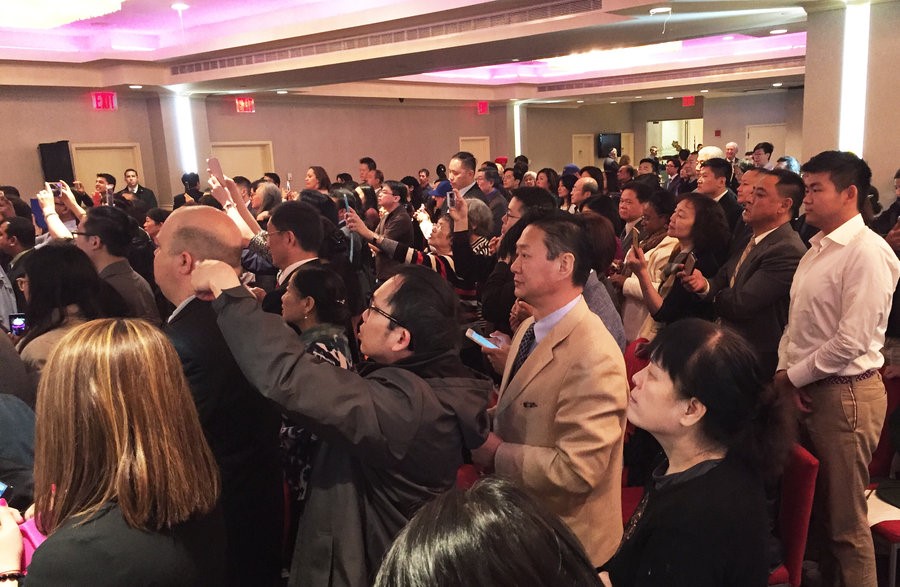Periscope. Facebook Live. Perhaps you’ve heard a few of these terms floating around in the ever-swelling sea of social media trends. Maybe you watched Sunday’s presidential debate from a live stream hosted on YouTube or have even “gone live” yourself and treated your friends to hilarious footage of your dog chasing its tail around your kitchen table. Video streaming platforms like Twitter’s Periscope, Facebook Live, and YouTube Live are the newest trend in social media, and enable a user to become a one-person news team with nothing more than a smartphone and free mobile app.

Supporters recording Hillary Clinton at a rally in Flushing, N.Y. Hansi Lo Wang/NPR
Making full use of new social media tools, the Coalition for Health Funding recently used Periscope to broadcast its annual “Public Health 101” congressional briefing on the threat of Zika to those who were unable to travel to Washington, D.C. The broadcast was successful, with more than 200 individuals viewing online from all areas of the country –more than tripling the size of our audience. You can watch an archive of the broadcast here.
Dr. Laura Riley speaks at the Coalition for Health Funding’s “Public Health 101” briefing on the threat of Zika. Emily Holubowich.
CRD Associates’ client, the Coalition for Health Funding has united more than 100 million patients, health care providers, public health professionals, and scientists to preserve and strengthen the nation’s investment in public health. During the last 45 years, the Coalition for Health Funding has continually innovated to ensure its methods of advocacy communicate the very human impact of funding health.
While the content shared on video-streaming platforms is often light-hearted, these platforms can also be an incredibly powerful tool for advocacy when used properly, allowing a viewer to share the same experience as the person posting the footage. Periscope and other streaming services can be used to keep a record of an event, conduct interviews with VIPs outside the office, or show what daily life is like inside your organization. Perhaps the most appealing aspect of Periscope and similar services is that they are free to use–making them an efficient way to reach large numbers of people at very low cost.
The power of these platforms was demonstrated in June when House Democrats staged a sit-in on the House chamber floor to raise awareness for gun violence legislation. Prohibited from broadcasting when Congress is not in session, traditional media was unable to share images or video of the activity with the American public. The protest might have fizzled out under the media blackout, but the congressional protestors took to the video streaming service Periscope and brought the protest directly to the hands of thousands of Americans, capturing the public’s attention for days after the event.
Woman using Periscope to film House Democrats on the chamber floor during sit-in on June 23, 2016. www.CNN.com
Based on the Coalition’s experience, here are 9 tips and tricks that can easily increase the impact of your broadcast:
- Always use a tripod. This makes your footage much less shaky for viewers, and also frees you up to do other things. If a tripod is unavailable, brace your arms against the arm of a chair or table to increase stability.
- Pay attention to the environmental recording conditions surrounding your smartphone. Often strong light sources or close noises can distract from the subject you are recording, but can be easily avoided by changing the placement of your phone.
- Tilt your phone horizontally. Most video footage is recorded in a horizontal format, and it will look more natural to your viewers.
- Always bring an extra battery. Recording continuously for multiple hours will easily drain your battery, and you don’t want to leave your audience hanging.
- Choose the streaming service that compliments your existing social media presence. If you have a strong Facebook following, utilize Facebook Live. If you’re based on Twitter, use Periscope. Organizations that normally post videos on YouTube could simply use YouTube’s Live platform.
- Advertise your broadcast ahead of time. Periscope connects directly with Twitter, and you can easily send viewers to your page ahead of time to ensure you have a large audience waiting for your broadcast.
- Vary your camera angles. Panning to the audience or to different members of a panel is a good way to keep your broadcast interesting.
- Consider supplementing your broadcast with live Tweets or other social media posts to connect with your viewers on multiple levels.
- When you are live, there is no way to retroactively edit what your audience has seen. If you want a polished, edited look to your videos, consider other recording services.